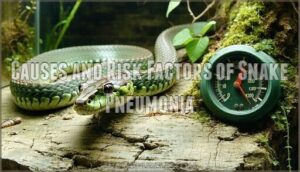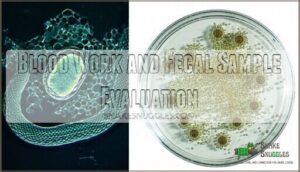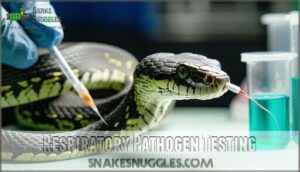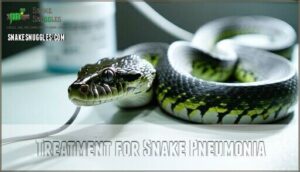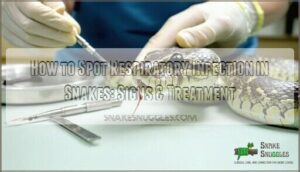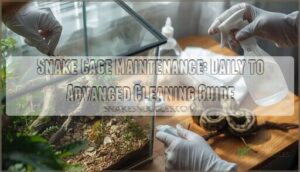This site is supported by our readers. We may earn a commission, at no cost to you, if you purchase through links.
 You’ll need a vet’s help to treat snake pneumonia effectively.
You’ll need a vet’s help to treat snake pneumonia effectively.
Treatment typically involves targeted antibiotics, anti-parasitic drugs, or antifungal medications depending on what’s causing the infection.
Your snake’s habitat needs immediate attention too—maintain proper temperature gradients and humidity levels to support recovery.
Supportive care like fluid therapy and consistent heat sources can make the difference between life and death.
Think of pneumonia as your snake’s lungs getting clogged up—they can’t breathe properly, so everything else starts failing.
The key is catching it early and acting fast.
Temperature control isn’t just helpful; it’s critical for your snake’s immune system to fight back.
Proper temperature gradients and humidity levels are essential for supporting your snake’s recovery.
Table Of Contents
- Key Takeaways
- How to Treat Snake Pneumonia?
- Recognizing Symptoms of Snake Pneumonia
- Causes and Risk Factors of Snake Pneumonia
- Diagnosing Snake Pneumonia
- Treatment for Snake Pneumonia
- How to Spot Respiratory Infection in Snakes
- How to Get Rid of Snake Pneumonia Bacteria
- How to Get Rid of a Snakes Respiratory Infection
- Home Treatment for Snake Pneumonia
- Prevention of Snake Pneumonia
- Costs Associated With Treating Snake Pneumonia
- Frequently Asked Questions (FAQs)
- What is effective snake respiratory infection care?
- Why does my snake have pneumonia?
- How do you treat a ball python respiratory infection?
- Do snakes have respiratory infections?
- How do I know if my snake has a respiratory infection?
- How do you treat a scaly snake?
- How to get rid of a snakes respiratory infection?
- How do I know if my snake has pneumonia?
- What is the best antibiotic for snakes?
- How to help a snake with RI?
- Conclusion
Key Takeaways
- You’ll need immediate veterinary care for proper diagnosis and targeted antibiotics – don’t attempt home treatment since snake pneumonia can be fatal without professional intervention and specific medications like enrofloxacin.
- Maintain your snake’s enclosure at the upper end of its temperature range and proper humidity levels (50-60%) to boost immune function and support recovery during treatment.
- Watch for early warning signs like open-mouth breathing, nasal discharge, wheezing sounds, and increased breathing effort – catching pneumonia early dramatically improves your snake’s chances of survival.
- Prevention beats treatment every time through proper husbandry including correct temperature gradients, regular enclosure cleaning, stress reduction, and quarantine protocols for new snakes.
How to Treat Snake Pneumonia?
Your snake’s pneumonia demands immediate action to prevent life-threatening complications.
Your slithery friend’s survival depends on swift action—pneumonia waits for no one.
Treating snake pneumonia requires targeted medications based on the specific pathogen – snake antibiotics for bacterial infections, antifungals for fungal causes, or antiparasitics for parasitic origins.
Reptile antibiotics like enrofloxacin are commonly prescribed, though drug resistance can complicate treatment.
Snake medication often includes nebulization specifics to deliver medication directly to the respiratory system.
Alternative therapies may supplement traditional treatments.
Post-treatment care focuses on ideal husbandry conditions.
While long-term prognosis varies, early intervention dramatically improves outcomes.
Snake pneumonia treatment success depends on swift veterinary intervention and proper supportive care.
Recognizing Symptoms of Snake Pneumonia
You’ll need to watch for specific warning signs that indicate your snake might be developing pneumonia, as early detection can mean the difference between a manageable illness and a life-threatening emergency.
Look for open-mouth breathing, nasal discharge, increased breathing effort, and lethargy – these symptoms often appear together and require immediate veterinary attention.
Identifying Symptoms
Spotting snake pneumonia symptoms early can save your pet’s life.
Watch for these warning signs that signal respiratory distress:
- Open-mouth breathing – Your snake gasps or breathes with its mouth open
- Nasal discharge – Clear or colored fluid from the nostrils
- Wheezing sounds – Audible breathing or crackling noises during respiration
These behavior changes often accompany appetite loss and increased respiratory rate.
Risk Factors
Understanding what makes your snake vulnerable helps prevent serious respiratory problems.
Several risk factors increase snake pneumonia likelihood, making prevention your best defense strategy.
Key contributors include:
- Mite Infestations that compromise respiratory health and create infection pathways
- Environmental Stressors like overcrowding, excessive handling, and temperature fluctuations
- Underlying Illnesses including untreated mouth infections or weakened immunity from previous diseases
- Husbandry Issues such as improper humidity, poor ventilation, and inadequate quarantine procedures
Stress and malnutrition further weaken your snake’s natural defenses against infectious agents.
Diagnosis Methods
When your snake shows signs of respiratory distress, accurate diagnosis methods become your roadmap to recovery.
Don’t let symptom overlap with other conditions fool you—veterinary expertise makes all the difference in distinguishing pneumonia from similar ailments.
Your vet will employ several diagnostic approaches:
- Imaging techniques like X-rays reveal lung inflammation and fluid accumulation that’s invisible to the naked eye
- Blood work and fecal sample evaluation uncover underlying infections and assess your snake’s overall health status
- Respiratory pathogen testing through PCR identifies specific bacteria, viruses, or fungi causing the infection
Secretion samples from your snake’s mouth or nose provide vital clues about the infection type.
While audible breathing might seem alarming, it’s actually helpful diagnostic information.
Differential diagnosis helps your vet doesn’t miss other potential causes, leading to targeted treatment that addresses the root problem effectively.
Factors such as stress and immune suppression can also increase a snake’s susceptibility to these infections.
Causes and Risk Factors of Snake Pneumonia
Snake pneumonia develops when bacterial, viral, or fungal infections overwhelm your pet’s respiratory system, often triggered by poor husbandry conditions like incorrect temperature and humidity levels.
You’ll find that stress, malnutrition, mite infestations, and weakened immune systems create the perfect conditions for these dangerous respiratory infections to take hold, which can be triggered by factors such as poor husbandry conditions.
Reptile Respiratory Risks
Your pet snake’s respiratory system works differently than mammals, making them vulnerable to specific health challenges. Reptile respiratory risks stem from their unique anatomy and ectothermic nature.
Environmental factors like improper temperature and humidity create perfect conditions for infection susceptibility. When you don’t maintain ideal conditions, your snake’s immune system weakens, opening doors to bacterial, viral, and fungal infections.
Emerging pathogens constantly threaten captive reptiles, while poor husbandry amplifies these risks. Stress from overcrowding, inadequate nutrition, and handling further compromises their defenses.
Long-term effects of respiratory infections can permanently damage lung function. Understanding these preventative measures helps you recognize when treating snake pneumonia requires immediate veterinary intervention with antibiotics and supportive care.
Snake Pneumonia Causes
Multiple factors trigger snake pneumonia causes in your pet.
Bacterial agents like Pseudomonas and E. coli attack weakened respiratory systems.
Viral infections including nidovirus spread quickly between snakes.
Fungal infections exploit poor conditions, while parasitic causes like lungworms damage airways.
However, husbandry issues remain the primary culprit:
- Incorrect temperature and humidity levels
- Poor enclosure cleanliness and ventilation
- Overcrowding and excessive handling stress
Preventing Snake Pneumonia
Now that you know what causes snake pneumonia, let’s talk about keeping your slithery friend healthy. Prevention beats treatment every time – like they say, an ounce of prevention is worth a pound of cure.
Proper husbandry forms your first line of defense against preventing snake pneumonia. You’ll want to nail down these key areas:
- Temperature and Humidity Control: Keep your snake’s environment within species-specific ranges. Poor humidity control creates respiratory stress, while incorrect temperatures weaken their immune system.
Quarantine protocols protect existing pets when introducing new snakes. Always isolate newcomers for 30-60 days. Stress reduction matters too – avoid excessive handling and maintain consistent routines.
Nutrition importance can’t be overstated; well-fed snakes resist infections better. Regular veterinary check-ups aid in early detection. Don’t forget mite prevention through regular habitat cleaning.
Routine veterinary care catches problems early, and strong immune system support through ideal conditions keeps respiratory infections at bay.
Diagnosing Snake Pneumonia
You’ll need a veterinarian to confirm snake pneumonia through specific diagnostic tests, as the symptoms often overlap with other respiratory conditions.
Your vet will typically use X-rays to examine your snake’s lungs, conduct blood work to identify infections, and perform specialized pathogen testing to determine the exact cause, which can help identify snake pneumonia.
Radiographs (X-rays)
X-rays reveal what’s hiding inside your snake’s respiratory system.
These radiographs show lung abnormalities that confirm snake pneumonia suspicions.
While X-ray interpretation helps with pneumonia visualization and anomaly detection, radiograph limitations mean you can’t rely solely on images for diagnosis.
Early detection through radiographs guides your vet toward the right treatment path.
| What X-rays Show | What They Miss | Why It Matters |
|---|---|---|
| Fluid in lungs | Specific bacteria type | Confirms infection presence |
| Lung inflammation | Viral vs bacterial cause | Shows disease severity |
| Abnormal air patterns | Treatment resistance | Guides next diagnostic steps |
Blood Work and Fecal Sample Evaluation
Blood work acts like a detective’s magnifying glass, revealing hidden clues about your snake’s health through bacterial identification and immune response analysis.
Meanwhile, fecal sample evaluation uncovers parasitic culprits lurking in your pet’s system.
Sample collection involves these diagnostic tests:
- Blood draws for complete blood count and chemistry panels
- Fresh fecal samples for parasite detection and fungal analysis
- Laboratory testing to identify specific pathogens
- Immune response markers indicating infection severity
Respiratory Pathogen Testing
Once blood work reveals infection markers, respiratory pathogen testing pinpoints the exact culprit behind your snake’s illness.
PCR testing identifies specific bacteria, viruses, or fungi within hours. Sample collection from nasal discharge or throat swabs provides material for analysis.
Culture sensitivity testing determines which antibiotics work best against the pathogen. Laboratory testing confirms test accuracy, while proper result interpretation guides targeted treatment for effective snake pneumonia diagnosis.
Recognizing oral redness can also be a warning sign.
Treatment for Snake Pneumonia
You’ll need targeted medications and supportive care to effectively treat your snake’s pneumonia, with treatment options varying based on whether the infection is bacterial, viral, fungal, or parasitic.
Your vet will prescribe specific antibiotics, anti-fungal drugs, or anti-parasitic medications while also providing supportive treatments like proper temperature management, fluid therapy, and oxygen support to help your snake recover.
Antibiotics, Anti-parasitic Drugs, Anti-fungal Medications
After confirming your snake’s pneumonia diagnosis, your vet will prescribe specific medications targeting the infection type. Antibiotics like enrofloxacin effectively combat bacterial infections, while antiparasitic drugs eliminate parasites that compromise respiratory health. Antifungal medications such as itraconazole treat fungal respiratory infections.
Treating snake pneumonia requires precision in dosage calculation and strict adherence to treatment duration. Don’t stop medications early—this creates antibiotic resistance and allows infections to return stronger. Your vet will determine the exact snake pneumonia medication protocol based on lab results.
Watch for medication side-effects like appetite loss or lethargy. Some medications can cause drug interactions, so inform your vet about any other treatments your snake receives. Complete the full course even if symptoms improve. Think of it like following a recipe—skip steps and you won’t get the desired outcome. Reptiles often lack a true cough reflex, making it harder to clear infections.
Supportive Care and Proper Temperature Management
Beyond medication, your snake needs thorough supportive care during pneumonia treatment.
Temperature control becomes your top priority – maintain the heat gradient at the upper range to boost immune function.
Key supportive measures include:
- Monitor habitat humidity levels between 50-60% for ideal recovery
- Provide gentle heat support using under-tank heaters or ceramic elements
- Consider force-feeding risks only when absolutely necessary under veterinary guidance
Snakes experiencing these symptoms may have underlying respiratory issues. Fluid therapy prevents dehydration while nebulization benefits breathing by adding moisture to airways.
How to Spot Respiratory Infection in Snakes
Beyond watching for obvious distress, you’ll need to catch the subtle signs of snake respiratory disease before it becomes critical. Early indicators often appear as minor changes that many owners miss.
Here’s what to monitor:
- Nasal discharge – Clear or colored mucus around nostrils
- Open-mouth breathing – Gasping or mouth constantly open
- Increased breathing rate – Visible chest movement or rapid breathing patterns
- Oral inflammation – Red, swollen mouth tissue or gums
- Behavioral changes – Lethargy, decreased appetite, or unusual positioning
- Audible breathing – Wheezing, clicking, or other respiratory sounds
- Buoyancy issues – Uneven floating in aquatic species
- Discharge analysis – Frothy or bubbly secretions around mouth area
For effective treatment, consider using a reptile nebulizer device to administer medication.
How to Get Rid of Snake Pneumonia Bacteria
Getting rid of pneumonia bacteria in your snake requires a strategic approach that goes beyond basic care. The key lies in targeting the specific bacterial culprits while supporting your snake’s natural defenses.
- Increase the temperature at the upper end of your snake’s preferred range to boost immune function and help fight bacterial infections.
- Gently clean discharge from nostrils and around the glottis using cotton-tipped applicators dipped in warm water.
- Administer prescribed medications exactly as your veterinarian directs, including oral or injectable antibiotics and supportive fluids.
Bacterial culture testing helps identify the exact pathogen, allowing for targeted antibiotics rather than broad-spectrum treatments that might contribute to antibiotic resistance. Effective treatment may require specific snake antibiotics.
Always isolate infected snakes since many pneumonia bacteria spread between reptiles. Disinfecting enclosure surfaces regularly prevents reinfection while treating snake pneumonia effectively.
How to Get Rid of a Snakes Respiratory Infection
Treating snake pneumonia requires swift, decisive action to combat the infection effectively. Your reptile’s life depends on immediate veterinary intervention, as respiratory distress can escalate rapidly without proper medical care.
Here’s your action plan for treating snake pneumonia:
- Seek emergency veterinary care – Don’t wait; respiratory infections worsen quickly
- Administer prescribed antibiotics – Follow dosing schedules precisely to prevent drug resistance
- Provide nebulization therapy – Helps deliver medication directly to respiratory tissues
- Maintain ideal temperatures – Keep enclosure at species’ upper thermal range
- Consider immune boosters – Veterinarian-approved supplements support recovery alongside traditional treatment
Home Treatment for Snake Pneumonia
Unfortunately, no proven home treatment exists for snake pneumonia. You can’t safely treat this serious condition yourself.
However, you can provide supportive care while seeking veterinary help: maintain proper quarantine setup, guarantee adequate hydration methods, and optimize temperature. A proper setup includes essential quarantine products.
Skip herbal supplements and topical remedies—they’re ineffective and potentially harmful. Professional snake respiratory support requires immediate veterinary intervention for survival.
Prevention of Snake Pneumonia
You’ll prevent most snake pneumonia cases by maintaining proper temperature gradients, humidity levels, and keeping your snake’s enclosure spotlessly clean.
Think of prevention as your snake’s insurance policy – it’s far easier and cheaper than treating a sick reptile later, which is why prevention is key.
Suitable Husbandry Practices
Proper husbandry forms your snake’s first line of defense against pneumonia.
Focus on enclosure size that allows natural movement, appropriate substrate choice for easy cleaning, and maintaining excellent water quality.
Include suitable enrichment items while following strict quarantine protocols for new arrivals.
Ideal humidity levels are also essential for preventing respiratory issues.
These foundational practices substantially reduce respiratory infection risks through consistent environmental management.
Temperature Regulation and Habitat Cleaning
When fighting pneumonia prevention, temperature regulation and habitat cleaning form your snake’s first line of defense.
Proper temperature gradients between 78-88°F help your snake’s immune system function effectively. Poor husbandry creates the perfect storm for respiratory infections.
Your snake’s health depends on these critical factors:
- Temperature regulation prevents immune system weakness that invites infection
- Humidity control between 50-60% stops bacterial growth while protecting respiratory tissues
- Substrate choices like cypress mulch allow proper moisture retention without harboring pathogens
- Disinfection protocols using reptile-safe cleaners eliminate harmful bacteria weekly
- Ventilation effectiveness guarantees fresh air circulation prevents stagnant, infection-prone environments
Consistent habitat cleaning and proper husbandry practices make pneumonia prevention manageable, not overwhelming.
Costs Associated With Treating Snake Pneumonia
Snake pneumonia treatment can drain your wallet faster than you’d expect.
Understanding these expenses helps you prepare for the financial commitment ahead.
- Medication Expenses – Antibiotics like enrofloxacin and antifungal drugs vary in cost based on treatment duration
- Veterinary Fees – Initial consultations range $30-$100, with specialized exotic vet rates potentially higher
- Hospitalization Costs – Severe cases requiring oxygen therapy and supportive care can reach thousands
- Follow-up Care – Regular monitoring visits confirm recovery progress and prevent relapse
Treatment options depend on severity and your vet’s recommendations.
Frequently Asked Questions (FAQs)
What is effective snake respiratory infection care?
You’ll need antibiotics from a reptile vet, plus proper temperature and humidity control. Support recovery with nebulization therapy, oxygen if needed, and maintain your snake’s enclosure at ideal warmth levels.
Why does my snake have pneumonia?
Ironically, your "perfectly healthy" snake likely developed pneumonia from poor husbandry you thought was fine.
Wrong temperatures, humidity levels, stress from handling, dirty enclosures, or untreated infections create perfect conditions for respiratory illness.
How do you treat a ball python respiratory infection?
You’ll need antibiotics from a reptile vet, plus supportive care like proper heating and humidity.
Keep your ball python at ideal temperatures, provide oxygen therapy if needed, and follow medication schedules strictly.
Provide these conditions to ensure your ball python recovers well.
Do snakes have respiratory infections?
Like a canary in a coal mine, your snake’s breathing tells a story.
Yes, snakes absolutely get respiratory infections from bacteria, viruses, fungi, and parasites.
You’ll notice open-mouth breathing, nasal discharge, and wheezing sounds.
How do I know if my snake has a respiratory infection?
Watch for open-mouth breathing, nasal discharge, wheezing sounds, or labored breathing.
You’ll notice increased breathing effort, lethargy, and reduced appetite.
If your snake’s breathing becomes visible or audible, seek veterinary care immediately.
How do you treat a scaly snake?
Visit an exotic veterinarian immediately for proper diagnosis. They’ll prescribe antibiotics based on culture results, provide supportive care like fluid therapy, and adjust your snake’s temperature and humidity for recovery.
How to get rid of a snakes respiratory infection?
Like clearing fog from a windshield, you’ll need veterinary antibiotics to eliminate your snake’s respiratory infection.
Maintain proper temperature and humidity while following prescribed medication schedules.
Early treatment prevents complications and guarantees faster recovery.
How do I know if my snake has pneumonia?
Watch for open-mouth breathing, wheezing sounds, nasal discharge, and increased breathing effort.
You’ll notice lethargy, reduced appetite, and visible rib movement during breathing.
These symptoms require immediate veterinary attention for proper diagnosis.
What is the best antibiotic for snakes?
Enrofloxacin is the most commonly prescribed antibiotic for snake respiratory infections.
Your vet might also recommend ampicillin or cloxacillin based on culture results.
Don’t self-medicate—proper diagnosis guarantees you’ll get the right treatment.
How to help a snake with RI?
While serious illness strikes fear, respiratory infections respond well to prompt care.
You’ll need immediate veterinary attention for proper antibiotics, maintain ideal heat and humidity, and provide supportive care including nebulization therapy.
Conclusion
Surprisingly, many snake owners think their pet’s wheezing is just "character development"—but pneumonia doesn’t build personality, it destroys lives.
Learning how to treat snake pneumonia isn’t optional; it’s essential for responsible ownership.
You’ve got the knowledge now: recognize symptoms early, seek veterinary care immediately, and maintain proper habitat conditions.
Temperature control, humidity management, and quick antibiotic treatment make the difference between recovery and tragedy.
Your snake’s breathing depends on your swift action and dedication.
- https://www.reptileknowledge.com/reptile-pedia/what-is-reptiles-pneumonia
- https://www.petplace.com/article/reptiles/general/pneumonia-in-snakes
- https://wpvet.com/reptile-rounds/respiratory-infections/
- https://issuu.com/exoticskeeper/docs/ekm_52pp_a4_1_1_/s/25688260
- https://www.vetlexicon.com/exotis/reptiles/respiratory/articles/pneumonia/




